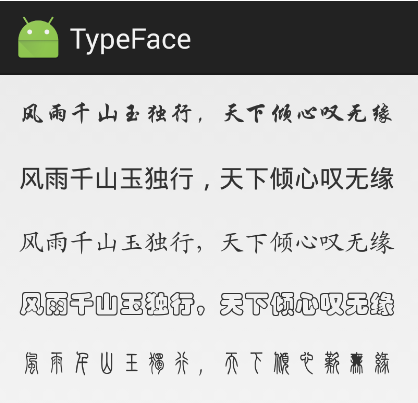您好,登錄后才能下訂單哦!
您好,登錄后才能下訂單哦!
一、使用系統自帶的字體
開發Android的人大多都知道,Android里面對字體的支持少得可憐,默認情況下,TextView 的 typeface 屬性支持 sans、serif和monospace 這三種字體,如果在沒有指定字體的情況下,系統會使用 sans 作為文本顯示的字體。但這三種字體只支持英文,也就是說只要你顯示的文字是中文,無論你選擇這三種字體中的哪一種,顯示效果都是一樣的。
1.在XML文件中設置
<!-- 使用默認的sans字體--> <TextView android:id="@+id/sans" android:text="Hello,World" android:textSize="20sp" android:typeface="sans" /> <!-- 使用默認的serifs字體--> <TextView android:id="@+id/serif" android:text="Hello,World" android:textSize="20sp" android:typeface="serif" /> <!-- 使用默認的monospace字體--> <TextView android:id="@+id/monospace" android:text="Hello,World" android:textSize="20sp" android:typeface="monospace" />
2.在Java代碼中設置
第一步: 獲取TextView實例
//獲取textView實例 TextView textView = findViewById(R.id.textview);
第二步:設置字體
//設置serif字體 textView.setTypeface(Typeface.SERIF); //設置sans字體 textView.setTypeface(Typeface.SANS_SERIF); //設置monospace字體 textView.setTypeface(Typeface.MONOSPACE);
二、為TextView添加字體庫
Android系統自帶有對字體的設置,這些設置是對字體的顯示方式的設置,比如加粗、傾斜、下劃線、字號等,但是并沒有提供對于字體類型的徐選擇,比如設置成楷體、隸書或雅黑等。Android系統只固定默認一種字體類型,所以如果開發人員需要修改字體類型,那么就必須需自己引入字體庫。
1.引入字體庫的實現
第一步:在assets目錄下新建fonts目錄,并把ttf字體文件放到該目錄下。
第二步:在Java代碼中實現
//實例化TextView TextView textView = findViewById(R.id.textview); //得到AssetManager AssetManager mgr=getAssets(); //根據路徑得到Typeface Typeface tf=Typeface.createFromAsset(mgr, "fonts/pocknum.ttf"); //設置字體 textView.setTypeface(tf);
2.引入字體庫后的效果圖

三、為TextView添加描邊
Android的默認控件TextView,相信大家都不會陌生,但是原生的TextView是不支持描邊效果的,但是在實際的開發過程中,經常會遇到為TextView添加描邊的需求,因此就要對原生的TextView進行拓展,使其支持自定義內部和外部顏色的描邊TextView。描邊效果的實現原理其實很簡單,無非就是獲取到TextPaint類,先進行一次比默認大小的文字內容稍微大一點的繪制,然后再進行一次默認大小的文字內容的繪制,然后通過屬性設置兩種不同的顏色,這樣就產生出了描邊效果。
為TextView添加描邊,要用到TextPaint的幾個屬性:
TextPaint paint = outlineTextView.getPaint(); //實例化TextPaint對象 paint.setStrokeWidth(15); //設置描邊的寬度 paint.setStyle(Paint.Style.STROKE);//設置畫筆屬性為描邊 strokeTextView.setTextColor(Color.parseColor(“#000000”)); //設置描邊的顏色(不能與文本顏色一致)
其中strokeTextView為自定義TextView的實例,代碼如下:
1.在構造函數中添加
public class StrokeTextView extends TextView {
private TextView outlineTextView = null;
public StrokeTextView(Context context) {
super(context);
outlineTextView = new TextView(context);
init();
}
public StrokeTextView(Context context, AttributeSet attrs) {
super(context, attrs);
outlineTextView = new TextView(context, attrs);
init();
}
public StrokeTextView(Context context, AttributeSet attrs, int defStyle) {
super(context, attrs, defStyle);
outlineTextView = new TextView(context, attrs, defStyle);
init();
}
public void init() {
TextPaint paint = outlineTextView.getPaint();
paint.setStrokeWidth(3); //描邊寬度
paint.setStyle(Style.STROKE);
outlineTextView.setTextColor(Color.parseColor("#000000")); //描邊顏色
outlineTextView.setGravity(getGravity());
}
@Override
public void setLayoutParams (ViewGroup.LayoutParams params) {
super.setLayoutParams(params);
outlineTextView.setLayoutParams(params);
}
@Override
protected void onMeasure(int widthMeasureSpec, int heightMeasureSpec) {
super.onMeasure(widthMeasureSpec, heightMeasureSpec);
//設置輪廓文字
CharSequence outlineText = outlineTextView.getText();
if (outlineText == null || !outlineText.equals(this.getText())) {
outlineTextView.setText(getText());
postInvalidate();
}
outlineTextView.measure(widthMeasureSpec, heightMeasureSpec);
}
@Override
protected void onLayout (boolean changed, int left, int top, int right, int bottom) {
super.onLayout(changed, left, top, right, bottom);
outlineTextView.layout(left, top, right, bottom);
}
@Override
protected void onDraw(Canvas canvas) {
outlineTextView.draw(canvas);
super.onDraw(canvas);
}
}
2.重寫onDraw方法
public class StrokeTextView extends TextView {
private TextView outlineTextView = null;
private TextPaint strokePaint;
public StrokeTextView(Context context) {
super(context);
outlineTextView = new TextView(context);
}
public StrokeTextView(Context context, AttributeSet attrs) {
super(context, attrs);
outlineTextView = new TextView(context, attrs);
}
public StrokeTextView(Context context, AttributeSet attrs, int defStyle) {
super(context, attrs, defStyle);
outlineTextView = new TextView(context, attrs, defStyle);
}
@Override
public void setLayoutParams (ViewGroup.LayoutParams params) {
super.setLayoutParams(params);
outlineTextView.setLayoutParams(params);
}
@Override
protected void onMeasure(int widthMeasureSpec, int heightMeasureSpec) {
super.onMeasure(widthMeasureSpec, heightMeasureSpec);
AssetManager manager = context.getAssets();
String path = "fonts/new_text.ttf";
Typeface type = Typeface.createFromAsset(manager, path);
//設置輪廓文字
CharSequence outlineText = outlineTextView.getText();
if (outlineText == null || !outlineText.equals(this.getText())) {
outlineTextView.setText(getText());
outlineTextView.setTypeface(type);
setTypeface(type);
postInvalidate();
}
outlineTextView.measure(widthMeasureSpec, heightMeasureSpec);
}
@Override
protected void onLayout (boolean changed, int left, int top, int right, int bottom) {
super.onLayout(changed, left, top, right, bottom);
outlineTextView.layout(left, top, right, bottom);
}
@Override
protected void onDraw(Canvas canvas) {
AssetManager manager = context.getAssets();
String path = "fonts/new_text.ttf";
Typeface type = Typeface.createFromAsset(manager, path);
if (strokePaint == null) {
strokePaint = new TextPaint();
}
//復制原來TextViewg畫筆中的一些參數
TextPaint paint = getPaint();
strokePaint.setTextSize(paint.getTextSize());
strokePaint.setTypeface(type);
strokePaint.setFlags(paint.getFlags());
strokePaint.setAlpha(paint.getAlpha());
//自定義描邊效果
strokePaint.setStyle(Paint.Style.STROKE);
strokePaint.setColor(Color.parseColor("#000000"));
strokePaint.setStrokeWidth(4);
String text = getText().toString();
//在文本底層畫出帶描邊的文本
canvas.drawText(text, (getWidth() - strokePaint.measureText(text)) / 2,
getBaseline(), strokePaint);
super.onDraw(canvas);
}
}
以上就是本文的全部內容,希望對大家的學習有所幫助,也希望大家多多支持億速云。
免責聲明:本站發布的內容(圖片、視頻和文字)以原創、轉載和分享為主,文章觀點不代表本網站立場,如果涉及侵權請聯系站長郵箱:is@yisu.com進行舉報,并提供相關證據,一經查實,將立刻刪除涉嫌侵權內容。